What Is The Focal Length (In M) Of A Makeup Mirror That Has A Power Of 1.55 D?
4.7 Epitome Formation by Mirrors
Summary
- Illustrate paradigm formation in a flat mirror.
- Explicate with ray diagrams the formation of an image using spherical mirrors.
- Determine focal length and magnification given radius of curvature, altitude of object and image.
We but have to look every bit far as the nearest bath to find an instance of an image formed by a mirror. Images in flat mirrors are the same size as the object and are located behind the mirror. Like lenses, mirrors can form a variety of images. For example, dental mirrors may produce a magnified image, only every bit makeup mirrors exercise. Security mirrors in shops, on the other hand, grade images that are smaller than the object. We volition use the police of reflection to understand how mirrors course images, and nosotros will detect that mirror images are analogous to those formed by lenses.
Effigy 1 helps illustrate how a flat mirror forms an epitome. Ii rays are shown emerging from the aforementioned indicate, striking the mirror, and being reflected into the observer's eye. The rays tin diverge slightly, and both all the same get into the eye. If the rays are extrapolated backward, they seem to originate from a common bespeak behind the mirror, locating the paradigm. (The paths of the reflected rays into the middle are the same equally if they had come directly from that indicate backside the mirror.) Using the law of reflection—the angle of reflection equals the angle of incidence—we tin can run across that the image and object are the aforementioned distance from the mirror. This is a virtual prototype, since it cannot be projected—the rays only announced to originate from a common signal behind the mirror. Obviously, if you walk behind the mirror, you cannot run into the epitome, since the rays practise not become at that place. Simply in forepart of the mirror, the rays comport exactly as if they had come from behind the mirror, so that is where the paradigm is situated.
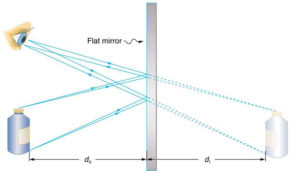
When pets see themselves in mirrors they are often confused. Here is a link to a good commodity on animals and the "mirror test" of self-recognition. http://www.animalcognition.org/2015/04/fifteen/listing-of-animals-that-have-passed-the-mirror-test/. Here is a cute true cat video to illustrate this betoken. The cat's owner posted this. You can discover the direct link at: https://youtu.be/SlxdAJmeLcQ
Now let us consider the focal length of a mirror—for instance, the concave spherical mirrors in Figure 2. Rays of light that strike the surface follow the law of reflection. For a mirror that is big compared with its radius of curvature, as in Effigy 2(a), we see that the reflected rays do not cross at the same point, and the mirror does not have a well-defined focal signal. If the mirror had the shape of a parabola, the rays would all cantankerous at a single betoken, and the mirror would have a well-divers focal point. But parabolic mirrors are much more expensive to make than spherical mirrors. The solution is to use a mirror that is pocket-sized compared with its radius of curvature, every bit shown in Figure 2(b). (This is the mirror equivalent of the sparse lens approximation.) To a very good approximation, this mirror has a well-defined focal point at F that is the focal distancef from the centre of the mirror. The focal lengthf of a concave mirror is positive, since information technology is a converging mirror.
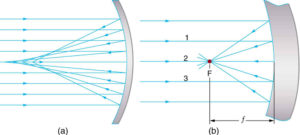
Just as for lenses, the shorter the focal length, the more than powerful the mirror; thus, P = 1/f for a mirror, too. A more than strongly curved mirror has a shorter focal length and a greater power. Using the law of reflection and some uncomplicated trigonometry, it can be shown that the focal length is one-half the radius of curvature, or
[latex]f= \frac{R}{2} ,[/latex]
where R is the radius of curvature of a spherical mirror. The smaller the radius of curvature, the smaller the focal length and, thus, the more powerful the mirror.
The convex mirror shown in Figure 3 also has a focal point. Parallel rays of low-cal reflected from the mirror seem to originate from the bespeak F at the focal distancef behind the mirror. The focal length and ability of a convex mirror are negative, since it is a diverging mirror.
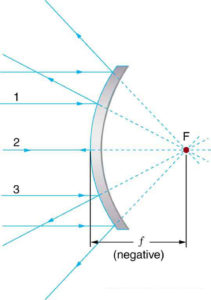
Ray tracing is as useful for mirrors as for lenses. The rules for ray tracing for mirrors are based on the illustrations but discussed:
- A ray approaching a concave converging mirror parallel to its axis is reflected through the focal point F of the mirror on the aforementioned side. (See rays one and 3 in Figure 2(b).)
- A ray approaching a convex diverging mirror parallel to its axis is reflected so that it seems to come from the focal point F behind the mirror. (See rays 1 and three in Effigy three.)
- Any ray striking the center of a mirror is followed by applying the law of reflection; it makes the same angle with the axis when leaving every bit when approaching. (See ray 2 in Figure 4.)
- A ray approaching a concave converging mirror through its focal point is reflected parallel to its axis. (The reverse of rays ane and three in Effigy 2.)
- A ray approaching a convex diverging mirror by heading toward its focal signal on the opposite side is reflected parallel to the centrality. (The reverse of rays 1 and iii in Effigy 3.)
We will employ ray tracing to illustrate how images are formed by mirrors, and we tin can apply ray tracing quantitatively to obtain numerical information. Only since nosotros assume each mirror is minor compared with its radius of curvature, we can use the thin lens equations for mirrors only as we did for lenses.
Consider the state of affairs shown in Effigy 4, concave spherical mirror reflection, in which an object is placed farther from a concave (converging) mirror than its focal length. That is,f is positive and do > f , so that we may expect an image similar to the case 1 real prototype formed by a converging lens. Ray tracing in Figure 4 shows that the rays from a common point on the object all cross at a point on the same side of the mirror as the object. Thus a real image can exist projected onto a screen placed at this location. The paradigm distance is positive, and the image is inverted, then its magnification is negative. This is a case 1 image for mirrors. Information technology differs from the instance 1 paradigm for lenses simply in that the image is on the same side of the mirror every bit the object. Information technology is otherwise identical.
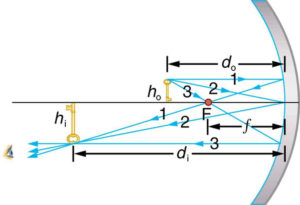
Example 1: A Concave Reflector
Electric room heaters use a concave mirror to reflect infrared (IR) radiation from hot coils. Note that IR follows the aforementioned police of reflection every bit visible light. Given that the mirror has a radius of curvature of 50.0 cm and produces an prototype of the coils 3.00 m away from the mirror, where are the coils?
Strategy and Concept
Nosotros are given that the concave mirror projects a real image of the coils at an image distance di = 3.00 m. The coils are the object, and nosotros are asked to find their location—that is, to find the object distance dodo. We are also given the radius of curvature of the mirror, so that its focal length is f = R/2 = 25.0 cm (positive since the mirror is concave or converging). Assuming the mirror is small-scale compared with its radius of curvature, we can use the thin lens equations, to solve this problem.
Solution
Sincedi andf are known, thin lens equation tin can be used to detect do:
[latex] \frac {ane} {d_o} \: + \: \frac{1} {di} =\frac {i}{f} .[/latex]
Rearranging to isolate do gives
[latex] \frac{1}{d_o} {=} \frac{1}{f} {-} \frac{1}{d_i} .[/latex]
Entering known quantities gives a value for 1/do:
[latex]\frac{one}{d_o} {=} \frac{ane}{ 0.250 \; {chiliad}} {-} \frac{1}{3.00 \;{m}} {=} \frac{three.667}{yard} .[/latex]
This must be inverted to discover do :
[latex] d_o = \frac{1 \;{m}} {three.667} = 27.3 \;{cm} .[/latex]
Discussion
Note that the object (the filament) is further from the mirror than the mirror's focal length. This is a case i image (do > f andfpositive), consequent with the fact that a real paradigm is formed. You volition become the most concentrated thermal energy direct in front of the mirror and iii.00 g away from it. Generally, this is not desirable, since it could cause burns. Usually, you lot desire the rays to emerge parallel, and this is accomplished past having the filament at the focal point of the mirror.
Note that the filament here is non much further from the mirror than its focal length and that the epitome produced is considerably further abroad. This is exactly coordinating to a slide projector. Placing a slide but slightly further abroad from the projector lens than its focal length produces an prototype significantly further away. As the object gets closer to the focal altitude, the image gets farther away. In fact, as the object distance approaches the focal length, the image distance approaches infinity and the rays are sent out parallel to i another.
Example ii: Solar Electric Generating System
One of the solar technologies used today for generating electricity is a device (chosen a parabolic trough or concentrating collector) that concentrates the sunlight onto a blackened pipe that contains a fluid. This heated fluid is pumped to a estrus exchanger, where its rut free energy is transferred to another system that is used to generate steam—and so generate electricity through a conventional steam cycle. Figure 5 shows such a working arrangement in southern California. Concave mirrors are used to concentrate the sunlight onto the pipe. The mirror has the guess shape of a section of a cylinder. For the problem, presume that the mirror is exactly one-quarter of a full cylinder.
- If nosotros wish to place the fluid-conveying pipe 40.0 cm from the concave mirror at the mirror's focal signal, what volition be the radius of curvature of the mirror?
- Per meter of pipe, what will be the amount of sunlight full-bodied onto the pipe, assuming the insolation (incident solar radiation) is 0.900 kW/mtwo ?
- If the fluid-carrying pipe has a ii.00-cm bore, what will be the temperature increase of the fluid per meter of piping over a menstruum of one minute? Assume all the solar radiations incident on the reflector is captivated by the pipe, and that the fluid is mineral oil with a density of 800 kg/chiliad3. (expect it up)
Strategy
To solve an Integrated Concept Problem nosotros must offset place the physical principles involved. Part (a) is related to the current topic. Part (b) involves a footling math, primarily geometry. Function (c) requires an agreement of heat and density.
Solution to (a)
To a good approximation for a concave or semi-spherical surface, the signal where the parallel rays from the dominicus converge will be at the focal point, so R = 2f =fourscore.0 cm.
Solution to (b)
The insolation is 900 Due west/10002 . We must detect the cross-exclusive areaA of the concave mirror, since the ability delivered is (900 W/m2 ) ten (A). The mirror in this case is a quarter-section of a cylinder, and then the expanse for a length Fifty of the mirror is A = i/4 (two π r) Fifty. The area for a length of i.00 m is then
A = ane/4 (2 π r) Fifty = A = (π/ii) R L = (3.14159/2) (0.800 chiliad) (1.00 k) = 1.26 grand2
The insolation on the 1.00-g length of piping is then
( 900 Westward/mii) ( 1.26 one thousand2 ) = 1130 W
Solution to (c)
The increase in temperature is given byQ = mc ΔT. The massm of the mineral oil in the i-meter section of pipe is
[latex] m = \rho V = \rho \pi ( \frac {d}{2})^2 (1.00 \: m) [/latex]
[latex] = (800 \times 10^2 \: {kg} / grand^3 ) ( three.14) { (0.0100 yard) }^two (ane.00 \: chiliad) = 0.251 \: {kg}.[/latex]
Therefore, the increment in temperature in i minute is
[latex]\Delta T = \frac {Q} {mc} = \frac { (1130 \: W)( 60.0 \: southward) } { ( 0.251 \: { kg} ) (1670 \: J \cdot \: { kg/}^{\circ} C) } [/latex] = 162 °C
Discussion for (c)
An assortment of such pipes in the California desert tin can provide a thermal output of 250 MW on a sunny day, with fluids reaching temperatures every bit high as 400 oC. We are considering merely one meter of pipe here, and ignoring estrus losses along the pipage.
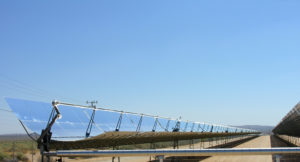
What happens if an object is closer to a concave mirror than its focal length? This is analogous to a case ii image for lenses (do< f andf positive), which is a magnifier. In fact, this is how makeup mirrors act equally magnifiers. Effigy vi(a) uses ray tracing to locate the image of an object placed close to a concave mirror. Rays from a common point on the object are reflected in such a manner that they appear to be coming from behind the mirror, significant that the image is virtual and cannot be projected. As with a magnifying drinking glass, the epitome is upright and larger than the object. This is a example 2 image for mirrors and is exactly analogous to that for lenses.
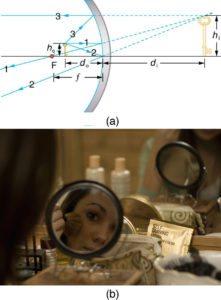
All three rays appear to originate from the same point after being reflected, locating the upright virtual image behind the mirror and showing it to exist larger than the object. (b) Makeup mirrors are perhaps the most mutual use of a concave mirror to produce a larger, upright image.
A convex mirror is a diverging mirror (f is negative) and forms only one type of image. It is a case 3 paradigm—one that is upright and smaller than the object, merely equally for diverging lenses. Figure seven(a) uses ray tracing to illustrate the location and size of the case 3 image for mirrors. Since the image is backside the mirror, it cannot be projected and is thus a virtual image. It is also seen to exist smaller than the object.
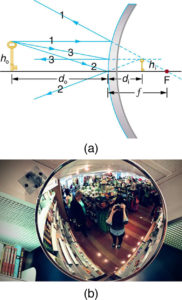
Example iii: Image in a Convex Mirror
A keratometer is a device used to measure the curvature of the cornea, particularly for plumbing fixtures contact lenses. Light is reflected from the cornea, which acts similar a convex mirror, and the keratometer measures the magnification of the paradigm. The smaller the magnification, the smaller the radius of curvature of the cornea. If the lite source is 12.0 cm from the cornea and the image's magnification is 0.0320, what is the cornea's radius of curvature?
Strategy
If nosotros can find the focal length of the convex mirror formed by the cornea, we can find its radius of curvature (the radius of curvature is twice the focal length of a spherical mirror). Nosotros are given that the object distance is do = 12.0 cm and that m = 0.0320. We first solve for the image distance di , and then for f .
Solution
yard = – di / do . Solving this expression for di gives
di = -chiliad do.
Entering known values yields
di = – (0.0320) (12.0 cm) = -0.384 cm.
[latex] \frac {1}{f} {=} \frac{1}{d_o} {+} \frac{one}{d_i} [/latex]
Substituting known values,
[latex]\frac{1}{f} {=} \frac{1}{12.0 \;{cm}} {+} \frac{1}{-0.384 \;{cm}} {=} \frac{-ii.52}{cm}.[/latex]
This must be inverted to find f:
[latex]f = \frac{cm}{-two.52} = -0.400 \: {cm} [/latex]
The radius of curvature is twice the focal length, so that
R = 2 |f| = 0.800 cm.
Word
Although the focal lengthf of a convex mirror is defined to be negative, nosotros accept the absolute value to give us a positive value for R. The radius of curvature constitute here is reasonable for a cornea. The distance from cornea to retina in an developed eye is most 2.0 cm. In practice, many corneas are non spherical, complicating the job of plumbing fixtures contact lenses. Note that the image distance here is negative, consistent with the fact that the image is behind the mirror, where it cannot be projected. In this section's Problems and Exercises, y'all will prove that for a fixed object distance, the smaller the radius of curvature, the smaller the magnification.
The three types of images formed by mirrors (cases 1, two, and 3) are exactly analogous to those formed by lenses, as summarized in the table at the end of Affiliate on Image Formation past Lenses. It is easiest to concentrate on just three types of images—and then retrieve that concave mirrors act like convex lenses, whereas convex mirrors act like concave lenses.
Accept-Home Experiment: Concave Mirrors Close to Home
Discover a flashlight and identify the curved mirror used in it. Detect some other flashlight and polish the get-go flashlight onto the second ane, which is turned off. Estimate the focal length of the mirror. You might attempt shining a flashlight on the curved mirror behind the headlight of a car, keeping the headlight switched off, and make up one's mind its focal length.
Trouble-Solving Strategy for Mirrors
Pace ane. Examine the state of affairs to determine that paradigm formation past a mirror is involved.
Step two. Refer to the Trouble-Solving Strategies for Lenses. The same strategies are valid for mirrors as for lenses with one qualification—use the ray tracing rules for mirrors listed earlier in this section.
Section Summary
- The characteristics of an image formed by a flat mirror are: (a) The image and object are the same distance from the mirror, (b) The image is a virtual image, and (c) The image is situated behind the mirror.
- Image length is half the radius of curvature.
[latex] f = \frac{R}{2}[/latex]
- A convex mirror is a diverging mirror and forms only one type of paradigm, namely a virtual prototype.
Conceptual Questions
one: What are the differences betwixt real and virtual images? How tin can y'all tell (by looking) whether an image formed by a single lens or mirror is existent or virtual?
ii: Tin can yous meet a virtual epitome? Can y'all photograph one? Can one be projected onto a screen with additional lenses or mirrors? Explain your responses.
3: Is information technology necessary to project a real image onto a screen for it to exist?
4: At what distance is an epitome always located—at do, di, orf?
5: Under what circumstances will an image be located at the focal indicate of a lens or mirror?
6: What is meant by a negative magnification? What is meant by a magnification that is less than 1 in magnitude?
7: Can a case i image exist larger than the object even though its magnification is ever negative? Explicate.
8: Effigy 8 shows a light bulb betwixt two mirrors. 1 mirror produces a beam of light with parallel rays; the other keeps light from escaping without beingness put into the beam. Where is the filament of the light in relation to the focal point or radius of curvature of each mirror?
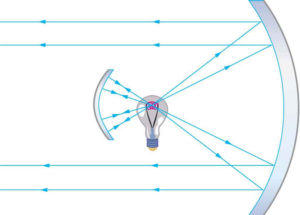
9: Devise an organization of mirrors allowing you lot to run into the back of your head. What is the minimum number of mirrors needed for this task?
10: If y'all wish to encounter your entire torso in a flat mirror (from head to toe), how tall should the mirror be? Does its size depend upon your distance away from the mirror? Provide a sketch.
11: Information technology can exist argued that a apartment mirror has an space focal length. If then, where does it grade an image? That is, how are di and do related?
12: Why are diverging mirrors often used for rear-view mirrors in vehicles? What is the main disadvantage of using such a mirror compared with a flat ane?
Problems & Exercises
1: What is the focal length of a makeup mirror that has a power of 1.l D?
2: Some telephoto cameras use a mirror rather than a lens. What radius of curvature mirror is needed to supplant a 800 mm focal length telephoto lens?
iii: (a) Calculate the focal length of the mirror formed by the shiny back of a spoon that has a three.00 cm radius of curvature. (b) What is its power in diopters?
4: Observe the magnification of the heater element in Example i. Note that its large magnitude helps spread out the reflected energy.
5: What is the focal length of a makeup mirror that produces a magnification of i.l when a person's face is 12.0 cm away? Explicitly show how you lot follow the steps in the Trouble-Solving Strategy for Mirrors.
6: A shopper continuing 3.00 thou from a convex security mirror sees his prototype with a magnification of 0.250. (a) Where is his image? (b) What is the focal length of the mirror? (c) What is its radius of curvature? Explicitly show how you lot follow the steps in the Problem-Solving Strategy for Mirrors.
7: An object 1.50 cm loftier is held three.00 cm from a person'south cornea, and its reflected image is measured to be 0.167 cm high. (a) What is the magnification? (b) Where is the paradigm? (c) Find the radius of curvature of the convex mirror formed by the cornea. (Note that this technique is used by optometrists to measure the curvature of the cornea for contact lens fitting. The instrument used is chosen a keratometer, or bend measurer.)
8: Ray tracing for a flat mirror shows that the paradigm is located a altitude behind the mirror equal to the distance of the object from the mirror. This is stated di = -do since this is a negative image altitude (information technology is a virtual prototype). (a) What is the focal length of a flat mirror? (b) What is its power?
9: Evidence that for a flat mirrorhi = ho knowing that the image is a distance behind the mirror equal in magnitude to the distance of the object from the mirror.
10: Use the police force of reflection to bear witness that the focal length of a mirror is half its radius of curvature. That is, prove that f = R/ii. Note this is true for a spherical mirror only if its bore is small compared with its radius of curvature.
11: Referring to the electrical room heater considered in the kickoff case in this section, calculate the intensity of IR radiations in West/g2 projected by the concave mirror on a person iii.00 m away. Assume that the heating chemical element radiates 1500 West and has an area of 100 cm2, and that half of the radiated power is reflected and focused past the mirror.
12: Consider a 250-Westward heat lamp fixed to the ceiling in a bathroom. If the filament in ane low-cal burns out then the remaining three nonetheless piece of work. Construct a problem in which you decide the resistance of each filament in lodge to obtain a sure intensity projected on the bathroom floor. The ceiling is iii.0 m high. The problem will demand to involve concave mirrors backside the filaments. Your teacher may wish to guide you on the level of complexity to consider in the electric components.
Glossary
- converging mirror
- a concave mirror in which low-cal rays that strike it parallel to its axis converge at i or more than points along the axis
- diverging mirror
- a convex mirror in which lite rays that strike it parallel to its axis bend abroad (diverge) from its axis
- law of reflection
- angle of reflection equals the angle of incidence
Solutions
Bug & Exercises
1: +0.667 1000
2: +1.60 1000
3: (a) -one.five 10 10-ii m (b) -66.vii D
iv: -11.0
5: +0.360 m (concave)
vi: di = -0.750 yard, f = -1.00 m c) R = 2.00 m
7: (a) +0.111 (b) -0.334 cm (behind "mirror") (c) 0.752 cm
11: m = -11.0, area = 0.110 m2, I= vi.82 kW/yard2
Source: https://pressbooks.bccampus.ca/introductorygeneralphysics2phys1207opticsfirst/chapter/25-7-image-formation-by-mirrors/
Posted by: terrellsuaing.blogspot.com

0 Response to "What Is The Focal Length (In M) Of A Makeup Mirror That Has A Power Of 1.55 D?"
Post a Comment